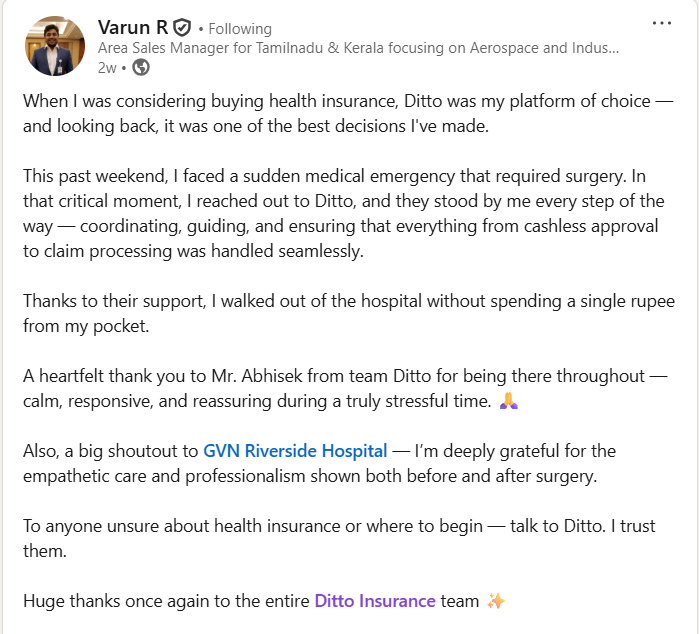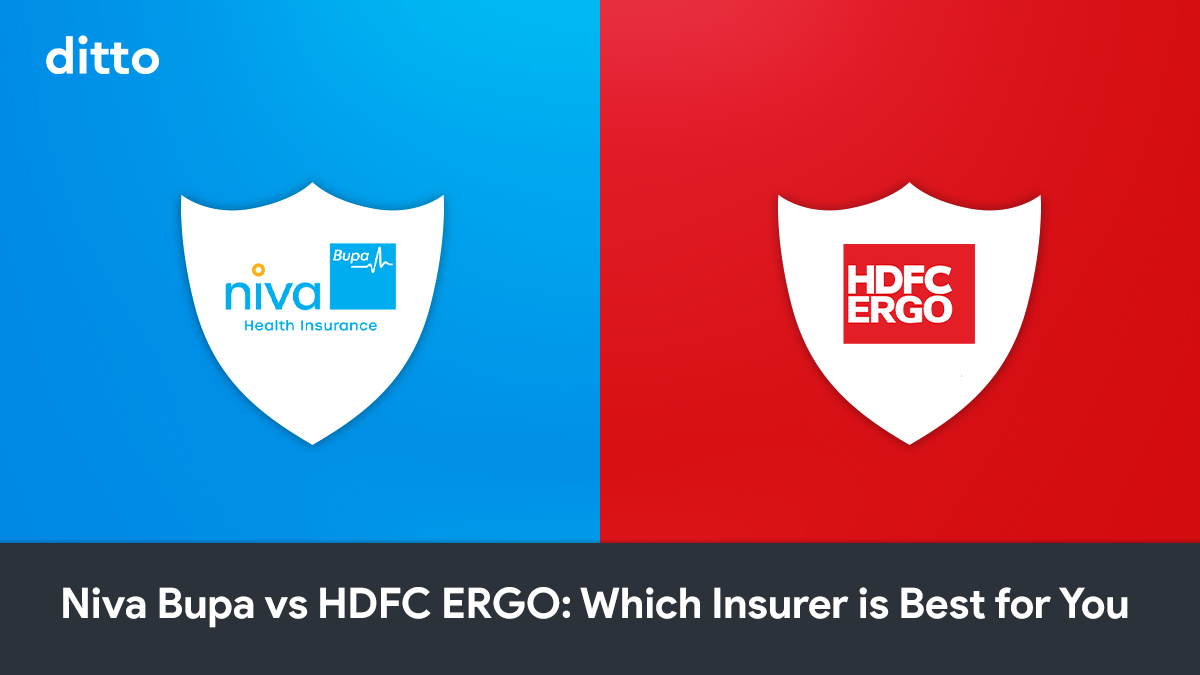| Niva Bupa vs HDFC Ergo: Which is Better? When comparing Niva Bupa vs HDFC ERGO, the choice depends on what you value more. Niva Bupa stands out with affordable premiums, feature-rich plans, along with wellness rewards and flexibility, making it an excellent pick for younger buyers or those seeking customizable, budget-friendly health coverage. On the other hand, HDFC ERGO is a large global insurer with strong Indian bank parentage. It offers a higher claim settlement ratio (97%), fewer complaints, and stronger reliability. This makes it ideal for those who prioritize service consistency and brand trust. |
Struggling to decide between Niva Bupa and HDFC ERGO for your health insurance? You're not alone. With rising healthcare costs, choosing the right insurer is more critical than ever, yet it can be more confusing.
Both insurers are popular, trusted, and offer solid plans, but they’re built for different needs. In this guide, we break down their strengths, weaknesses, and pricing, so you can choose what’s right for you.
Still unsure which plan fits your needs? Talk to Ditto’s advisors for clarity — no spam calls, no sales pitch, just simple, honest advice.
Niva Bupa vs HDFC ERGO: Company Overview
About Niva Bupa Health Insurance
Niva Bupa is a standalone health insurance company in India, meaning it focuses solely on health insurance, unlike general insurers that also cover home, fire, motor, travel, etc.
- Founded: 2008 (originally as Max Bupa)
- Ownership: A joint venture between True North (a private equity firm) and Bupa, a UK-based healthcare services expert, also listed on the stock exchange.
- Type: Standalone health insurer
- Branches: 200+ offices across India
Note: Niva Bupa rebranded from Max Bupa in 2021 and has since expanded its health portfolio significantly.
What this means for you: Being a standalone health insurer, Niva Bupa is wholly focused on health insurance. This often translates to more innovative and feature-rich plans, designed with a health-first mindset.
About HDFC ERGO Health Insurance
HDFC ERGO is a general insurance company offering health, motor, travel, home, and other types of insurance. It is a joint venture between HDFC BANK Ltd. and ERGO International AG (part of the Munich Re Group).
- Founded: 2002
- Type: General insurance company with a strong focus on health
- Branches: 300+ offices across India
Note: In 2020, HDFC ERGO merged with Apollo Munich Health Insurance, expanding its health portfolio further.
What this means for you: As a large, diversified insurer, HDFC ERGO brings financial stability and operational maturity to the table. With a long-standing presence in the industry and backing from two global giants, you can expect consistent claim handling, better customer service, and a solid reputation, critical during emergencies.
Now that we have a rough idea about the two insurance companies, let’s see how the two compare based on key performance metrics.
Niva Bupa vs HDFC ERGO: Key Differences (Comparison Table)
| Metric/Insurer | HDFC ERGO | Niva Bupa |
|---|---|---|
| Claim Settlement Ratio (Avg 2022-2025) | 96.71% | 91.62% |
| Incurred Claim Ratio (Avg 2021-2024) | 86% | 58% |
| Complaint Volume (Avg 2022-2025) Per 10,000 Claims | 9 | 43 |
| Gross Written Premium/ Annual Business (Avg 2022-2025) in Crores | ₹6,118 crores | ₹5,481 crores |
Note: The above metrics have been taken from HDFC ERGO’s and Niva Bupa’s annual reports, public disclosures, and the IRDAI-published statistics handbook.
Ditto’s Verdict: Based on these metrics, HDFC ERGO appears to perform significantly better in terms of claim processing, customer satisfaction, and scale.
But what do these metrics actually mean, and can Niva Bupa still be given a shot?
Niva Bupa vs HDFC ERGO: Claim Settlement Ratio
The Claim Settlement Ratio (CSR) reflects the number of claims that were settled out of the total number of claims received. Why is this important? This matters if you're worried about smooth claims handling.
Although Niva Bupa falls under the safe and recommended range of 90-100, it trails behind HDFC ERGO’s CSR.
Niva Bupa vs HDFC ERGO: Incurred Claim Ratio
The Incurred Claim Ratio (ICR) shows the proportion of the amount of claims paid to the amount of premiums collected.
Niva Bupa falls in the safe range of 50-80, but an ICR of 58% might indicate tight claim controls or under-utilization.
On the other hand, HDFC ERGO’s ICR of 86% can be considered slightly higher, though not dangerous.
In terms of solvency ratio, HDFC ERGO stands at a robust 1.997x, well above the IRDAI's recommended minimum of 1.5, as shown in this public disclosure. This indicates a strong financial stability. In comparison, Niva Bupa boasts an even more impressive solvency ratio of 3.03x, as detailed on page 30 of their public disclosure.
Niva Bupa vs HDFC ERGO: Complaint Volume
As seen in the comparison table, HDFC ERGO has a commendably low complaint volume of 9 per 10,000 claims, whereas Niva Bupa is evidently struggling with 43 complaints. Here, a high complaint ratio typically points to service-related issues, delays, or dissatisfaction in claims processing.
Note: Standalone health insurers like Care and Niva Bupa often report higher complaint ratios than diversified general insurers (e.g., HDFC ERGO, ICICI Lombard, Bajaj Allianz), since their complaints are concentrated in health insurance.
Niva Bupa vs HDFC ERGO: Gross Written Premium
The GWP indicates the business scale and how much premiums an insurance company collects in a given year from its total health insurance segment.
In the case of Niva Bupa vs HDFC ERGO, both are large players, but HDFC ERGO holds a higher market share, which reflects higher customer trust and reach.
Now that we’ve compared Niva Bupa vs HDFC ERGO based on key metrics, the next natural step is to take a look at their plan offerings.
Niva Bupa vs HDFC ERGO: Health Insurance Plans
| Plan | Key Features | Pros | Cons |
|---|---|---|---|
| HDFC ERGO Optima Secure | 2X sum insured from day one Becomes 4x with bonus and restoration No copay, room rent limit, or disease-wise limits Inbuilt consumables coverage |
Comprehensive riders for unlimited restoration, waiting period reduction & OPD Ideal for long-term security |
Plans priced higher than peers |
| HDFC ERGO Medisure Super Top Up | Affordable Super top-up plan with high deductible options Can work with any base policy |
Great for boosting existing coverage at low premiums | Requires coordination with base policy for claims Low sum insured options of up to ₹20L only |
| HDFC ERGO Energy Silver | Specially designed for diabetes and hypertension patients, offering day 1 coverage Includes disease management services |
Tailored plan for lifestyle diseases Includes wellness tracking |
Premiums may be higher for healthy individuals Limited appeal beyond the target group |
| Niva Bupa ReAssure 2.0 | Unlimited restoration, booster+ Loyalty and safeguard add-on for consumables coverage. |
Extremely flexible Lock the clock feature No capping on room rent, treatments |
Slightly complex to understand for first-time buyers. Higher premiums for older age groups |
| Niva Bupa Aspire | Customizable benefits Digital wellness features |
Excellent for young families or couples looking for maternity benefits Newborn coverage up to full sum insured, which is quite rare |
Still relatively new Lacks long-term performance data |
| Niva Bupa Health Recharge Super Top Up | Affordable super top-up Deductible-based structure |
Great for increasing cover at a low cost Simple design, covers up to ₹90L |
Has room rent limit and sublimits on modern treatments |
Ditto’s Verdict: Both HDFC ERGO and Niva Bupa offer solid health insurance plans, but they cater to slightly different needs.
HDFC ERGO’s plans, like Optima Secure, stand out for their comprehensive nature, simplicity, and reliability. However, they often lack advanced features like super bonus add-ons or wellness rewards.
Niva Bupa’s plans, especially ReAssure 2.0 and Aspire, go a step further with benefits like booster+ (up to 10x accumulation of unutilised sum insured), unlimited reinstatement, wellness tracking, and digital rewards, which are features not available in most HDFC ERGO plans.
Niva Bupa vs HDFC ERGO: Premium Comparison
For a premium comparison, let's consider different profiles living in Tier 1 cities, covered for an amount of 15 lakhs.
| Profile | HDFC ERGO Optima Secure | Niva Bupa ReAssure 2.0 Titanium+ |
|---|---|---|
| (Individual Plan): Age 25 |
₹14,060 | ₹12,145 |
| (Family Floater, 2A): Ages (31, 32) | ₹22,161 | ₹20,665 |
| (Family Floater, 2A 1C): Ages (35, 34, 5) | ₹27,087 | ₹26,980 |
| (Family Floater, 2A): Ages (62, 63) | ₹81,422 | ₹73,474 |
Ditto’s Verdict: Niva Bupa offers more competitive premiums compared to HDFC ERGO across various profiles, making Niva Bupa a more cost-effective choice overall.
Not sure which insurer fits your needs best? Get in touch with Ditto’s expert advisors for a personalized recommendation. Book a free call now.
Who Should Choose HDFC ERGO and Niva Bupa Health Insurance?
You should consider HDFC ERGO if:
You're looking for a health insurer with a strong and proven track record. With a high claim settlement ratio, lower complaint volumes, and a reputation for consistent service, HDFC ERGO is an excellent choice for those who prioritize reliability. It's especially suited for people who prefer not to be surprised during claim time and prefer dealing with a well-diversified and established insurer backed by HDFC Bank and Munich Re.
You Should Consider Niva Bupa if:
You want comprehensive features at a more affordable price point. Niva Bupa’s plans are especially attractive to younger buyers or families looking for customisation, maternity and newborn coverage, digital-first experiences, and wellness rewards. As a standalone health insurer, Niva Bupa is focused purely on health insurance, allowing it to build plans like ReAssure 2.0 and Aspire that offer flexibility, benefits stacking, and value for money.
Niva Bupa vs HDFC ERGO: Which is Better? Ditto’s Take
If you go purely by the numbers, HDFC ERGO stands out. They have better claim ratios, fewer complaints, and a stronger reputation.
However, that doesn’t mean Niva Bupa isn’t worth considering.
In fact, several of their plans (like ReAssure 2.0 and Aspire) are very competitive in terms of benefits, features, and premiums. From our own experience at Ditto, while Niva Bupa has occasionally had hiccups in post-sales and claims service, they've shown significant improvements and are constantly innovating their product line.
In 2025, we’re seeing more customers opt for Niva Bupa because of product innovation and affordability, especially younger buyers and first-timers.
Our take? Both Niva Bupa and HDFC ERGO are dependable insurers and can be considered. However, if you are okay with the slightly higher pricing and less competitive features of HDFC, we’ve had a better claims experience with them, and they’re more reliable.
Full Disclosure, both HDFC ERGO and Niva Bupa are partnered with us, but we're still committed to recommending only the best insurers. Both of them meet our high standards, and they definitely make Ditto's cut.
Why Choose Ditto for Health Insurance
At Ditto, we’ve assisted over 7,00,000+ customers with choosing the right health insurance policy. Why customers like Varun below love us:

✅No-Spam & No Salesmen
✅Rated 4.9/5 on Google Reviews by 12,000+ happy customers
✅Backed by Zerodha
✅100% Free Consultation
You can book a FREE consultation. Slots are running out, so make sure you book a call now!
Conclusion
HDFC ERGO wins in performance metrics and brand reliability. Niva Bupa excels in flexibility, affordability, and plan design. There’s no one-size-fits-all answer. It really depends on your needs, age, medical history, and budget.
Don’t just go by popularity or price. Choose the insurer that matches your life stage, budget, and coverage expectations. And remember, no plan is perfect, but the right plan for you is out there. And that’s precisely where Ditto can help.
Frequently Asked Questions (FAQs)
Are premiums more affordable with Niva Bupa or HDFC Ergo?
In most cases, Niva Bupa offers more affordable premiums, especially for younger individuals or families. Their plans are also more customizable, allowing you to tailor coverage based on budget. HDFC ERGO’s premiums may be slightly higher, but you're paying for their stronger claims track record and reliability.
Which health insurer has a better claim settlement ratio: Niva Bupa or HDFC Ergo?
HDFC ERGO has the edge here, with an average claim settlement ratio of 97%, compared to Niva Bupa’s 92% (2022-2025). This indicates a higher likelihood of smooth claim processing with HDFC ERGO.
Which is best, Niva Bupa or HDFC ERGO?
There’s no one-size-fits-all answer. HDFC ERGO is better if you value reliability, fewer complaints, and proven performance. Niva Bupa is great for those looking for modern, feature-rich plans at a lower cost. It ultimately depends on your needs, age, and budget.
What are the disadvantages of Niva Bupa?
While Niva Bupa offers innovative and affordable plans, there are a few trade-offs:
- Higher complaint volume (43 per 10,000 claims)
- Lower claim settlement ratio compared to peers
- The claims process and experience can be inconsistent, as per past customer feedback
That said, they’ve been improving steadily over the past few years.
Are both insurers profitable?
Yes, they are, as reported in HDFC and Niva Bupa’s annual reports.
Is Niva Bupa the best health insurance company?
Niva Bupa is among the top health insurers in terms of product design and innovation. However, whether it's the "best" depends on what you're looking for. If you want affordable, flexible, and benefit-rich coverage, Niva Bupa is a strong contender. But if claim service and legacy reputation are your top priorities, others like HDFC ERGO may be a better fit.
Last updated on:







